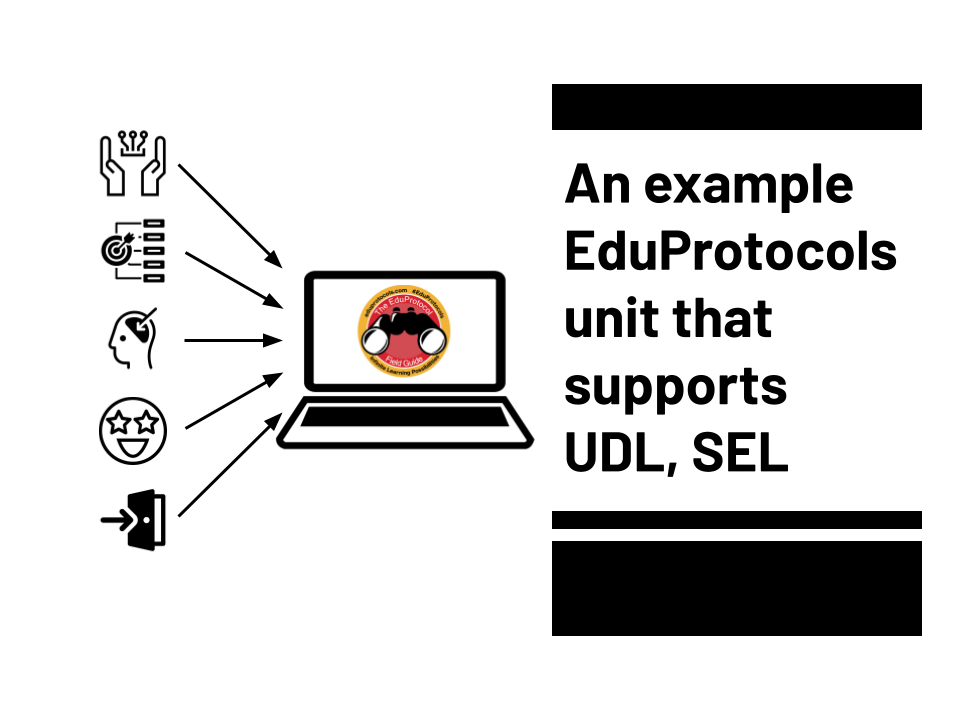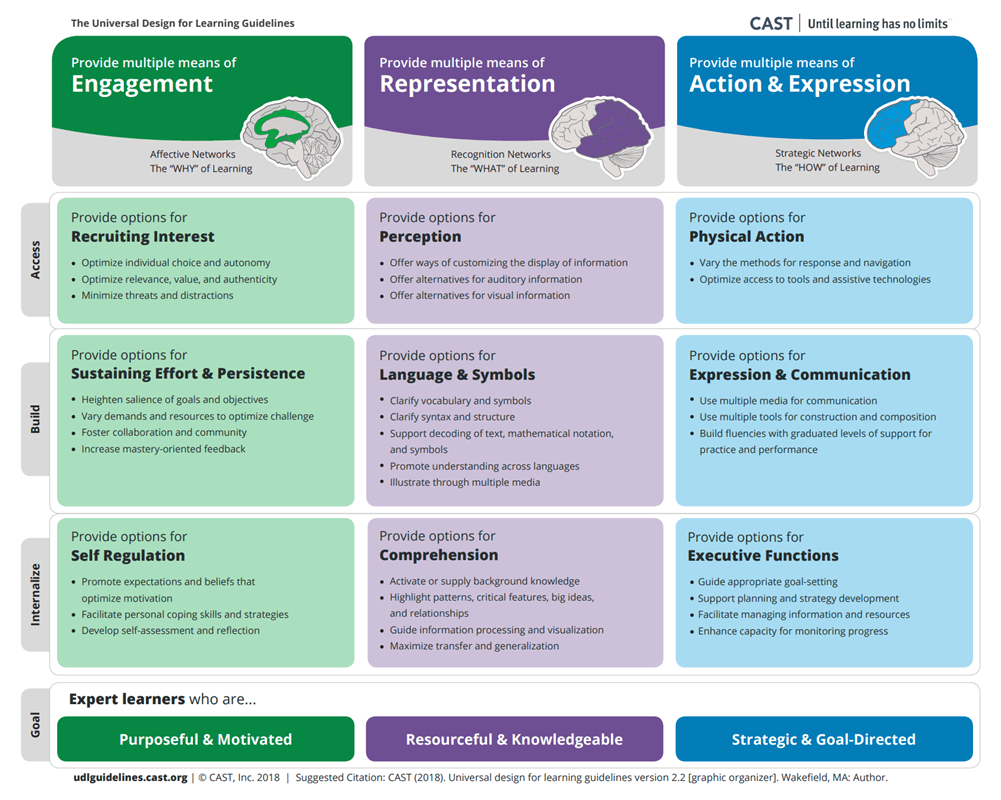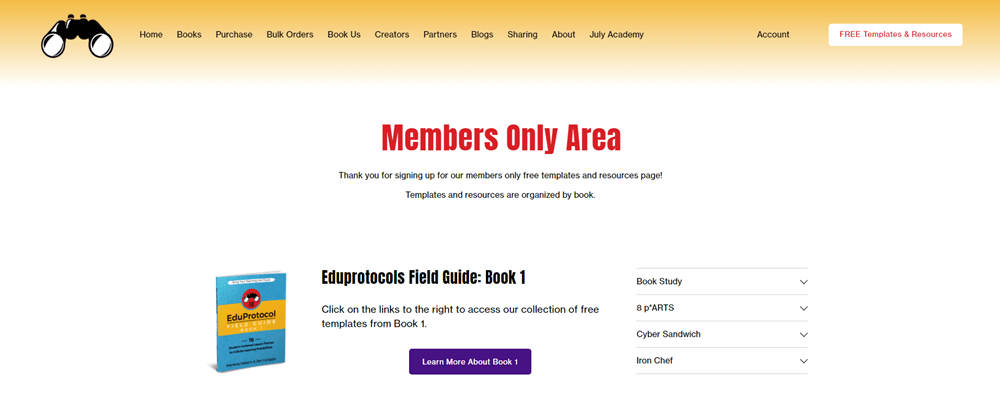
EduProtocols activities can be used again and again to engage and teach. Here's how they look in a full unit.
This post is written by Kim Voge, an educator, instructional coach, adjunct professor, and ed tech consultant from California. Kim is the co-author of Deploying EduProtocols: 20+ Ways to Use EduProtocols to Transform Your School or District. Find her on Twitter at @KVoge71.
How can we ensure our lesson plans meet the needs of ALL of our students?
Now that students have access to powerful technology tools, it is time to integrate technology in meaningful, purposeful ways. Whether you are teaching face to face or virtually, EduProtocols allow teachers to work less, teach better…and most importantly…students achieve more!
What are EduProtocols?
EduProtocols are a set of strategies you can use to simplify planning and get results. They're simple activities you can use over and over again, adjusting for new content. They have fun names, like Fast and the Curious, Cyber Sandwich, and Booka Kucha. Call them "lesson frames," like picture frames. You can change the content (the picture) inside a picture frame, but the frame always stays the same.
They are not a product you purchase. Once you start using these activity ideas, they are a way of life! You can find lots of examples at EduProtocols.com.
Created originally by Jon Corippo and Marlena Hebern, the EduProtocols community has expanded vast and wide to ensure all subject areas and all grade levels benefit from their use. EduProtocols are open pedagogy that work with any content area or curriculum.
EduProtocols support Universal Design for Learning
We know the two years of pandemic-era remote teaching have had a huge impact on our jobs in the classroom. We know we want students to be successful. We want to be effective teachers. We want ALL students to experience growth in their learning. This seems like such an insurmountable task. With the varied levels and abilities of our students, what is a teacher to do?
This is where EduProtocols come in. They really provide the HOW when teachers need to meet the diverse needs of learners, provide multiple means of learning opportunities, build relationships with students, and address social-emotional learning.
Universal Design for Learning is a framework for teaching that helps teachers improve and optimize teaching and learning for all people based on scientific insights into how humans learn. It provides for ...
- Engagement, the "why" of learning (affective networks in the brain)
- Representation, the "what" of learning (recognition networks in the brain)
- Action and Expression, the "how" of learning (strategic networks in the brain)

CAST (2018). Universal Design for Learning Guidelines version 2.2. Retrieved from http://udlguidelines.cast.org
Example unit: How Kim deploys EduProtocols
Here’s an example showing how the elements of lesson design, UDL, and EduProtocols can align for effective lesson planning. This is from my 5th grade American Revolution Unit.

Part 1 of the Unit: Objective and Purpose
Lesson: Fast and Curious about events on the "Road to Revolution"
About the Protocol: Fast and Curious is a gamified review of words, terms, basic facts, etc. using a computer-based game software and multiple reps. Repeated exposure to routine information is mastered by students. This also provides formative assessment data to inform instruction and establishes a growth mindset.
More about the Protocol: Eliminate worksheet homework with the Fast and the Curiou EduProtocol (post/video)
UDL Engagement Category: Sustaining Effort and Persistence
UDL Representation Category: Comprehension
UDL Action/Expression Category: Physical Action

Part 2 of the Unit: Anticipatory Set
Lesson: Thin Slide: What do you notice? What do you wonder?
About the Protocol: With Thin Slide, using a single slide, students find one picture and/or write one sentence for a word/term that is provided.
Thin Slide Protocol Template: Make a copy of the Google Slides template
UDL Engagement Category: Self Regulation
UDL Representation Category: Comprehension
UDL Action/Expression Category: Physical Action

Part 3 of the Unit: Input
Lesson: Great American Race with key terms, people, events.
About the Protocol: With Great American Race, using a shared slide deck, students gather information for a provided topic, date, person, etc. They find/record 5 clues about their given topic on the slide, but they do not label the topic on the slide. Students read the slides and try to match up the topic to the slide.
More about the Protocol: EduProtocols Live YouTube Video: The Great American Race with Brianna Davis
UDL Engagement Category: Recruiting Interest
UDL Representation Category: Comprehension
UDL Action/Expression Category: Executive Functions

Part 4 of the Unit: Modeling
Lesson: 8 Parts Primary Sources with Tea Party, Boston Massacre, etc. then Gallery Walk
About the Protocol: Like 8 p*ARTS, with 8 p*ARTS Primary Sources, students use a primary source to generate ideas for identifying the purpose and information contained in the primary source.
8 p*ARTS Primary Sources Protocol Template: Make a copy of the Google Drawings template
UDL Engagement Category: Sustaining Effort and Persistence
UDL Representation Category: Comprehension
UDL Action/Expression Category: Physical Action

Part 5 of the Unit: Check for Understanding
Lesson: Fast and Curious about events on the “Road to Revolution” and Frayer Model for unknowns
About the Protocol: The Frayer Model is a four-part graphic organizer for vocabulary acquisition. Click here for a Google Drawings template you can copy.
Frayer Model Resource: The Frayer EduProtocol video by Stephanie DeMichele
UDL Engagement Category: Sustaining Effort and Persistence
UDL Representation Category: Perception
UDL Action/Expression Category: Physical Action

Part 6 of the Unit: Guided Practice
Lesson: Cyber Sandwich events in small groups. Share summaries.
About the Protocol: With Cyber Sandwich, students read and annotate a passage or video individually. Then, in pairs or trios, students share what was annotated. Students summarize interdependently.
Cyber Sandwich Protocol Template: Make a copy of the Google Slides template
UDL Engagement Category: Self Regulation
UDL Representation Category: Perception
UDL Action/Expression Category: Executive Functions

Part 7 of the Unit: Closure
Lesson: Thin Slide exit ticket
About the Protocol: With Thin Slide, using a single slide, students find one picture and/or write one sentence for a word/term that is provided.
Thin Slide Protocol Template: Make a copy of the Google Slides template
UDL Engagement Category: Self Regulation
UDL Representation Category: Comprehension
UDL Action/Expression Category: Physical Action

Part 8 of the Unit: Independent Practice
Lesson: Mini Report for 3 events they wish to explore more.
About the Protocol: With Mini Report, students use a variety of input to write a short report, to build research and summary writing skills.
EduProtocol Resource: EduProtocol Mini Report video by Nathan DeGroot
UDL Engagement Category: Recruiting Interest
UDL Representation Category: Comprehension
UDL Action/Expression Category: Executive Functions
How UDL fits with deploying EduProtocols across a unit
Universal Design for Learning (cast.org) is of utmost importance as we design lessons to meet the diverse needs of learners. UDL is a function of the general education classroom and goes hand in hand with best, first instruction.
EduProtocols align with the principles of UDL in genuine, meaningful ways. For example, Iron Chef allows students to foster collaboration (Engagement), guide information processing and visualizing (Representation), and use multiple tools for construction and composition (Action/Expression). When we take multiple means of addressing learners' needs, we meet the needs of many rather than a few.
"Racking and stacking" EduProtocols
When it comes to planning effective lessons, teachers and layer multiple EduProtocols. I call this “Rack and Stack”. Like the chart above, you can see effective pedagogy and intentional lesson design in the example. When I was in the classroom, I found myself relying on the triad of Fast and Curious, Thin Slide, and CyberSandwich for a comprehensive lesson that could be taught in about an hour. I present many ideas and practical examples about how to do this through my book, Deploying EduProtocols, and in our very supporting Facebook group, EmpowerEDventure.
EduProtocols + social emotional learning
In addition to the technological needs of learning from a distance or integrating technology in effective ways, the EduProtocols support social and emotional learning (SEL). The Collaborative for Academic, Social, and Emotional Learning (CASEL) created a framework based on five core needs that are integral to the development of children.
SEL does not need a separate, isolated time in the school day. The more we can integrate these skills into the lessons we create, the better. The use of EduProtocols supports each of these areas. EduProtocols can be leveraged to incorporate life skills into everyday learning. Self-Awareness, Social Awareness, Responsible Decision-Making, Self-Management, and Relationship Skills, the five core needs, are exemplified in many of the EduProtocols where learning is scaffolded, chunked, and social.
Examples of SELs and EduProtocols
Self Awareness: Create consistency, repetition, and feedback with Fast and Curious and 8 pARTS
Social Awareness: Provide opportunities for collaboration and communication by using Cyber Sandwich and Iron Chef
Responsible Decision Making: By using EduProtocols on a regular basis, scaffolds and supports are provided for a gradual release of responsibility by lowering the cognitive load. All 4 C’s (creativity, collaboration, critical thinking, and communication) are inherent in the EduProtocols.
Self Management: Build executive functioning skills in students by providing manageable tasks for students to complete, receive actionable feedback, and feel successful
Relationships: Create connections among classmates to create a safe environment for learning and failure. With Frayer a Friend, students are sharing about themselves to a partner. The partner is recording what is being verbalized on a Frayer model. Students are building a relationship with each other and among other students as the pairs for quads to share about their partner.


